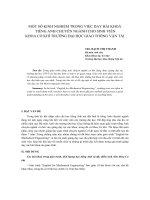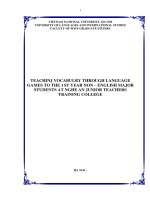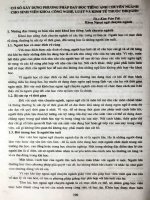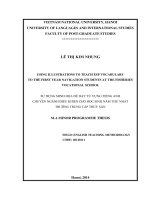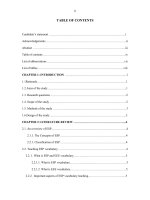Nghiên cứu về việc sử dụng Giáo cụ trực quan để dạy từ vựng tiếng Anh chuyên ngành cho sinh viên Khoa Đóng tàu Trường Cao đẳng nghề Giao thông Vận tải Trung ương II
Bạn đang xem bản rút gọn của tài liệu. Xem và tải ngay bản đầy đủ của tài liệu tại đây (215.34 KB, 13 trang )
Nghiên cứu về việc sử dụng Giáo cụ trực quan
để dạy từ vựng tiếng Anh chuyên ngành cho
sinh viên Khoa Đóng tàu Trường Cao đẳng
nghề Giao thông Vận tải Trung ương II
Bùi Thị Phương Thảo
Trường Đại học Ngoại ngữ
Luận văn ThS ngành: Lý luận và PP giảng dạy tiếng Anh; Mã số: 60 14 10
Người hướng dẫn: M.A. Vũ Thị Thu Thủy
Năm bảo vệ: 2012
Abstract: Teaching vocabulary is one of the most important aspects of teaching second
languages in general and of teaching English for Specific Purposes (ESP). However, this
aspect has not been fully given attention to in non-English major colleges in Vietnam.
The teachers of English for Specific Purposes (Ts) are facing many obstacles and trying
to come up with creative solutions to the problems of teaching ESP vocabulary. This
work is concerned with teaching ESP vocabulary by using visual aids for the students of
the Shipbuilding faculty at Central Vocational College of Transport No II. This thesis
attempts to investigate the situation of using visual aids to teach ESP vocabulary at
CVCOT (the purpose, teachers’ and students’ attitude, types of visual aids applied, stages
using visual aids, difficulties aids and benefits). Besides, the author would like to point
out some suggestions to improve the teaching and learning ESP vocabulary through
visual aids.
Keywords: Ngôn ngữ; Tiếng Anh; Phương pháp giảng dạy; Từ vựng; Giáo cụ trực quan
Content
PART 1: INTRODUCTION
1. Rationale of the study
Vocabulary teaching is one of the most important components of any language class. The main
reason is the fact that it is a medium, which carries meaning; learning to understand and express
the meaning is what counts in learning languages. There has been increased focus on teaching
vocabulary recently, “If language structures make up the skeleton of language, then it is
vocabulary that provides the vital organs and the flesh” (Harmer 1993:153). Vocabulary
functions as a cornerstone without which any language could not exist. Speaking would be
meaningless and perhaps impossible having only structure without vocabulary. A good mastery
of vocabulary is essential for learners, especially for those who learn for specific purposes. The
main objective of English for specific purposes has always been the teaching of highly
specialized vocabulary to specialists in various domains.
I myself have experienced 10 years of working as a teacher of English at the Central Vocational
College of Transport No.II where students will be future technicians and workers. Most of the
students here find learning ESP vocabulary the most challenging to them in acquiring English.
Our students’ biggest obstacle in learning ESP vocabulary is that it is difficult for them to
identify the meaning of, to understand the use of and to remember the words belonging to
technical terms. In fact, the students’ problems always haunt the teachers, which urge them to
find a suitable solution to ESP vocabulary teaching and learning at the college to satisfy the
students’ need.
The idea of using visual aids in teaching vocabulary is a good one. This can add colors to an
English lesson and motivate students to learn vocabulary, especially ESP vocabulary. There is no
reason for them to feel that learning vocabulary is dull. At my college, visual aids have been
used to teach ESP vocabulary. So I conduct this study to get an insight of the current situation of
using visual aids to teach ESP vocabulary at the Central Vocational College of Transport No.II.
It is hoped that this study will be of some values to my colleagues and those who want to
improve their ESP vocabulary teaching.
2. Aims of the study
To clarify the answer to the research question, the study aims at:
● Investigating the current situation of using visual aids to teach ESP vocabulary at the Central
Vocational College of Transport No.II.
● Exploring the difficulties facing teachers and students in teaching and learning ESP vocabulary
through visual aids.
● Providing some solutions to those difficulties to help teaching ESP vocabulary through visual
aids more effectively.
3. Scope of the study
Due to the time constraints and the scope of the study, the study only concentrates on how visual
aids are used to teach ESP vocabulary to the students of the Shipbuilding Faculty at CVCOT.
4. Significance of the study
The study is significant for the following reasons: firstly, it studies current situation of using
visual aids at CVCOT. Secondly it finds out difficulties in using visual aids to teach ESP
vocabulary. Thirdly, it suggests recommendations to teach ESP vocabulary more effectively. So
it is useful for both teachers and students of English. In addition, it would become a good source
of reference to those who are concerned with vocabulary teaching and learning.
5. Methods of the study
The method of this study is survey study because it was conducted by using questionnaires and
classroom observation to collect data. The data for the study came from two sources: teacher
respondents and student respondents at the Central Vocational College of Transport No.II.
Classroom observation was carried out to supplement the survey questionnaires, which is hoped
to bring more reliable results for the study.
6. Design of the study
The study consists of five chapters:
Chapter 1 is “Introduction”, which deals with the background, the rationale, the aims, the
scope, the methods, the significance and the design of the study.
Chapter 2, “Literature Review” presents a brief view on ESP, the theoretical background of
vocabulary and ESP vocabulary, the overall view of some visual aids.
Chapter 3, “Methodology” mentions the setting of the study, the participants, the instruments,
the data collection procedure, the data analysis procedure and a brief summary.
Chapter 4, “Data presentation and discussion” presents the data collected from the survey
questionnaires and class observation as well as the discussion of the data.
Chapter 5, “Implication and Conclusion” presents the pedagogical implications in teaching
ESP vocabulary through visual aids and the conclusion of the study. Suggestion for further study
is also given. Finally, the appendix presents the survey questionnaires.
PART 2: DEVELOPMENT
CHAPTER 1: LITERATURE REVIEW
1.1 An overview of ESP
1.1.1 The Definitions of ESP
1.2. Vocabulary in ESP teaching
1.2.1. Definition of vocabulary
1.2.2. Classification of vocabulary and ESP vocabulary
1.2.3. The issue of teaching ESP vocabulary
1.2.3.1. Selection of vocabulary for teaching
1.2.3.2. Stages in teaching vocabulary
1.2.3.2.1. Presenting
1.2.3.2.2. Practicing
1.2.3.2.3. Revising
1.3. Visual aids in teaching and learning vocabulary
1.3.1. Boards
1.3.2. Overhead projectors
1.3.3. Pictures
1.3.4. Objects
1.3.5. Gestures, mine, actions and performance
1.4. Benefits of using visual aids to teach vocabulary.
CHAPTER 2: METHODOLOGY
In this chapter, the research methodology chosen for the achievement of the aims and objectives
of the study will be discussed in detail.
2.1 Situation analysis
2.1.1. Teaching and learning situation
The Central Vocational College of Transport No.2 is located in Kien An district, Hai Phong city.
Founded in 1965, it is one of the colleges that have trained a lot of shipbuilders and technical
workers for Hai Phong city. At present, there are 76 classes with 1520 students placed into
different faculties. They are 7 faculties at CVCOT. More than a half of students are at the
Faculty of Shipbuilding. There are 15 English teachers here but only ten of them teach both GE
and ESP, the rest only teach GE. Students at the Central Vocational College of Transport No.2
need English for their future job. In order to read English drawings, documents written in
English to improve their career-related knowledge or work with foreigners, they have to learn
English well, especially ESP.
2.1.2. Textbook
English is taught for the first year and the second year students at CVCOT. Textbook for all the
first year students is Lifeline. It is the course of General English. Students start the course with
the beginners’ level of English and are supposed to obtain the elementary level in the end to gain
basic knowledge of English grammar and vocabulary to prepare for the following course of ESP.
ESP courses are courses for all the second year students. Textbook for second year students
depends on which faculty they are in. The textbook entitled “English for Shipbuilding” which is
edited by Do Thai Binh and other members in Van Phong group has been used in ESP course for
the students in Faculty of Shipbuilding. It consists of 30 lessons. Each lesson is divided into a
reading comprehension and a translation task. Each lesson is discovered in both grammar and
vocabulary aspects in which vocabulary accounts for a bigger percentage and are mostly
technical terminologies in shipbuilding.
2.1.3. Students
Students who learn at CVCOT do not have to pass an entrance exam. They enter the Vocational
College by their marks of three years at high school. So their level is low. Besides, their English
knowledge is very different because they are from different parts of the countries where living
conditions are poor and English is not paid much attention to. Generally, their English
proficiency is not high. When studying at CVCOT they have to take part in GE course and then
ESP course. Vocational students do not have any problems in getting knowledge about their
profession but ESP vocabulary. It is difficult for them to remember English words related to
machines, tools and equipment because these words are not used in everyday conversations. The
technical terminologies are often long and difficult to spell and pronounce. Moreover, some
students have negative attitudes to studying English. They suppose that English is not necessary
for their future career. They often argue that they will not need to use English as shipbuilders or
technical workers. Vocational students with a lack of motivation and some learning difficulties
with acquiring ESP vocabulary is a challenge for English teachers at CVCOT.
2. 2. Research methodology
2.2.1. Research questions
The main purpose of the study as mentioned in chapter one can be realized through the
questions:
1. What are the teachers’ and students’ attitudes toward the use of visual aids in
teaching and learning vocabulary in shipbuilding?
2. How do teachers use visual aids to teach vocabulary in shipbuilding?
3. What are the difficulties of teachers and students in using visual aids to teach and learn
vocabulary in shipbuilding?
4. What should be used to teach ESP vocabulary through visual aids more effectively?
2.2.2. The participants
The questionnaires have been prepared for two groups:
The first group includes ten English teachers. All of them had taught English for at least five
years at CVCOT and are experienced in teaching ESP courses for the students of Shipbuilding
Faculty. Among ten English teachers, five of them are Masters of Arts in English and three of
them are attending M.A courses. The other two are Bachelors of Arts.
The second group involves one hundred second year students at the Shipbuilding Faculty at
CVCOT. They all have finished GE course with the textbook “Lifelines” and are taking part in
ESP course with the textbook “English for Shipbuilders”.
2.2.3. The instruments
2.2.3.1. Instrument A- Survey questionnaires
In this study, in order to collect the data, two sets of survey questionnaires were administered to
get information about the use of visual aids in teaching and learning vocabulary in shipbuilding.
One is designed for teachers and another for students to investigate the aims and the objectives of
the study. Nine questions are delivered to ten English teachers and eight ones are for one
hundred second year students at the Faculty of Shipbuilding. In order that the respondents could
be free to express their specific thoughts about the items raised in questionnaires, some questions
have free answer put at the last choice of the answer. The questionnaires for students aim at
finding out their attitudes towards the use of visual aids in learning vocabulary in shipbuilding,
what they think of the way in which teachers use visual aids to teach vocabulary and their
difficulties in learning vocabulary in shipbuilding through visual aids. The questionnaires for
teachers aim at discovering their attitudes towards the use of visual aids in learning vocabulary in
shipbuilding, collecting information about how visual aids are really used in teaching vocabulary
in shipbuilding in class, teachers’ difficulties and suggestions for better use of visual aids to
teach vocabulary.
2.2.3.2. Instrument B - Class observation
Parallel with survey questionnaires, class observation was carried out before and during the time
the questionnaires were conducted. It was applied in this study to test what students had revealed
in the questionnaires and also clarify the validity of information about using visual aids at
CVCOT. Class observation was employed among three classes which are at the Faculty of
Shipbuilding. Each class was picked up randomly from its group. The observation was done
three times during the school year 2011-2012, each of which lasted for 45 minutes.
CHAPTER 3: DATA PRESENTATION AND DISCUSSION OF MAJOR FINDINGS
3.1 Data presentation
3.1.1. Data from the survey questionnaires
3.1.1.1 The teachers’ and the students’ attitudes towards the use of visual aids in teaching and
learning vocabulary
3.1.1.2. The teachers’ and the students’ opinion on purposes of teaching and learning vocabulary
in shipbuilding
3.1.1.3. Frequency of visual aids used in teaching vocabulary and students’ impression of visual
aids
3.1.1.4. The stages at which visual aids are often used and the students’ response
3.1.1.5. Benefits of using visual aids to teach and learn vocabulary in shipbuilding
3.1.1.6. The teachers’ and students’ difficulties in teaching and learning vocabulary in
shipbuilding through visual aids
3.1.1.7. The suggestions made by the teachers for using visual aids to teach vocabulary in
shipbuilding
3.1.2. Data analysis of the observation
3.2. Discussion of major findings
3.2.1. The situation of current teaching and learning ESP vocabulary
Among the purposes of teaching and learning vocabulary in shipbuilding, most of students have
a thought of learning vocabulary in shipbuilding to pass the exams. This reveals that there is not
much motivation in the current process of teaching and learning shipbuilding technical terms at
CVCOT. To arouse students’ motivation, the teachers had improvement in teaching methods.
They used visual aids to teach shipbuilding technical terms. This is highly appreciated by the
students. 100% of the students are interested in learning vocabulary in shipbuilding through
visual aids. 70% of the students find that visual aids help them a lot in learning vocabulary in
shipbuilding. The use of visual aids, thus, is hoped to increase the students’ motivation in ESP
vocabulary lessons.
3.2.2. The kind of visual aids to teach ESP vocabulary
The teachers have been using different types of visual aids to teach technical terms in reality.
Among these, objects, pictures and overhead projectors, especially objects are used with highest
frequency in most ESP vocabulary lessons. Chalkboard drawings are sometimes used, while
gestures, mine, actions and performance are rarely exploited. Definitely, it was observed that it is
sometimes more meaningful to present new word meanings by demonstration because
demonstration or mine is very helpful to highlight a particular word and help associate it in the
students’ mind with both visual and aural memories.
3.2.3. The frequency of using visual aids to teach ESP vocabulary
The order of frequency for using visual aids to teach ESP vocabulary from the teachers’ survey
questionnaire is as follows:
● The most frequently used visual aids are: objects, pictures, overhead projectors.
● Visual aids sometimes employed are: chalkboard drawings, gestures, mine, actions and
performance
The teachers show their interests in using such visual aids as objects, overhead-projectors and
pictures. With these visual aids, the teachers can organize activities in teaching ESP vocabulary
in various ways such as translation, using pictures exploited from the course book or from the
internet, playing the game, etc.
3.2.4. The stages at which visual aids are used most often in ESP vocabulary lessons
Among three main stages, presentation stage is most often carried out with visual aids in ESP
vocabulary lessons because the activities at these stages are free and easy for the teachers to apply
visual aids to. In practice stage, the teachers also use visual aids to help the students have images of
ESP words in their mind. In revision stage, the teachers use visual aids but not often. The teachers
also let their students revise what they have learnt at home because of the limit of time.
3.2.5. The difficulties in using visual aids to teach ESP vocabulary
Although the students gain a great number of benefits from learning ESP vocabulary through
visual aids, some of them do not really see the beneficial aspects of the activity. In other words,
these students experience boredom, distraction or even confusion during the lesson when visual
aids are employed to assist teachers’ vocabulary presentation. The percentage of this student
group is not very high; however, this is a problem that the teachers should consider in planning
their teaching.
PART 3: CONCLUSION
1. Implications
According to the results of the questionnaires, there are some problems arising in ESP
vocabulary teaching and learning through visual aids. In this part, some solutions to the problems
and practical recommendations for a better use of visual aids in teaching ESP vocabulary at
CVCOT are provided.
It is undeniable that when adopting visual aids in teaching ESP vocabulary, the students are
interested in the lively information and willing to join in language activities. Visual aids should
be made full use of in ESP vocabulary lessons. Teachers are encouraged to employ various kinds
of visual aids, increase the frequency of using visual aids and use visual aids in as many stages as
they can.
Moreover, from the data collected the most prominent problems the teachers have are the lack of
time and visual aids. It is advisable that the teachers should know to choose and make visual aids
quickly and economically and apply them appropriately.
Furthermore, according to Gardner (1985), students’ feelings, interests, needs, should be taken
into consideration when investigating the factors causing low motivation for learning English.
These sometimes affect the success of the lessons, especially for understanding the vocabulary.
Therefore, it is very important to help students to build up their motivation for acquiring
vocabulary by raising their awareness of their understanding new words.
Finally, the teachers should bear in mind that without basic knowledge of the subject, the
teachers can not make their ESP vocabulary lessons successfully. Therefore, they need to be
experts in the subject matter. The ESP teachers at CVCOT should be trained in shipbuilding by
attending the workshops, conferences or lectures of their colleagues in the field of shipbuilding
or they can self-study to get general knowledge of the subject matter and build up confidence to
handle the specialized content.
2. Conclusions
Visual aids are really a large category which may be employed to teach vocabulary as well as
grammar and all language skills. This study has presented the application of visual aids in
teaching ESP vocabulary for the students at the Faculty of Shipbuilding, CVCOT.
From this research study, it can be concluded that ESP teachers at Central Vocational College of
Transport No.II are aware of the role of visual aids in teaching ESP vocabulary. It can be seen
clearly that the teaching of ESP vocabulary at CVOT is not effective enough. The students are
not equipped with necessary skills to learn ESP vocabulary. Inexperienced teaching methods and
the gap on professional knowledge are considered to be great challenges.
The thesis comes up with several suggestions. These include strategies for teachers to teach ESP
vocabulary and the training for the teachers to improve their classroom techniques and
professional knowledge. The teachers should take into account things such as choice and kind of
visual aids, students’ background.
In conclusion all the aims of the study have been achieved and it is hoped that the study will
make a considerable contribution to better the current situation of teaching ESP vocabulary in
medicine to the second year students at CVOT.
3 Limitations of the study
In this study, I have made great effort and gained an insight into the situation of using visual aids
to teach ESP vocabulary at CVCOT. However, due to strict time and experience, limitations are
unavoidable.
Firstly, the number of the teachers and the students involved in the survey is limited, so the
findings, to some extents, may not be generalized for all students at CVCOT.
Secondly, the focus of the study is on the situation of using visual aids to teach ESP vocabulary
while other aspects of using visual aids through ESP vocabulary have not been taken into
consideration.
4. Suggestions for further study
It is firstly suggested that the limitations of this study will be overcome in further studies with
the increased number of participants. Secondly, more class observations should be carried out to
provide more reliable information.
Moreover, other aspects of using visual aids to teach English such as grammar, speaking,
listening, reading and writing should be employed in further studies.
Thus, this study has come to a certain extent and succeeded in answering the research questions.
Hopefully, this research would serve as a considerably good source of information to the
teachers at CVCOT and others teachers who concern in using visual aids to teach ESP
vocabulary. Any suggestions and comments from others teachers and colleagues are really
highly appreciated.
REFERENCES
1. Billow F.L. (1961), The techniques of language teaching, Longman, London.
2. Carter D. (1983), Some prepositions about ESP. The ESP Journal, 2, 131-137.
3. Chamberlain A. (1980). The impact of audio-visual aids in the language classroom.
Guidelines for audio-visual aids, 4, 1-22.
4. Dictionary of English Language and Culture. (1998). Spain: Addison Wesley Longman.
5. Doff A. (1988), Teaching English: A training course for Teachers, Cambridge University
Press.
6. Dudley-Evans T., St John M. (1998), Development in ESP: A multi-disciplinary approach.
Cambridge: University Press.
7. Flower J., Berman M.(1989), Build up with your Vocabulary. England: Language Teaching
Publications.
8. Fraser S. (2005). The lexical characteristics of specialized texts. In K. Bradford. Watts, C.
Ikeguchi, & M. Swanson (EDs.). JALT 2004 Conference Proceedings. Tokyo: JALT.
9. Gairns R., Redman S. (2003), Working with Words. Cambridge University Press.
10. Gardner R.C. (1985). Social psychology and second language learning. London: Edward
Arnold Ltd.
11. Gower R., Phillip D., Walters, S. (2005). Teaching practice: A handbook for teachers in
training, Macmillan books for teachers. Oxford: Macmillan Publishers Limited.
12. Harmer J. (1991), The practice of English Language Teaching, Cambridge: Longman.
13. Harmer J. (1993), The practice of English language teaching. Essex: Longman Group UK
Limited.
14. Hornby A. (1995), Oxfords advanced learners dictionary of current English. Oxford
University Press.
15. Hutchinson T., Water A. (1987). English for specific Purposes: A learner-centered
approach, Cambridge University Press.
16. Richards J., Platt J. (1992). Longman dictionary of language teaching and applied
linguistics. Essex: Longman.
17. Robinson P.C. (1991), ESP today: A practitioners guide, London: Prentice Hall.
18. Strevens P. (1988), “ESP after twenty years: a Pre-appraisal” in Makhan 1. Tickoo (Ed.),
ESP: state of the art, SEAMEO Regional Language Center.
19. Thornbury S. (2002). How to teach vocabulary. Essex, England: Pearson Education Limited.

